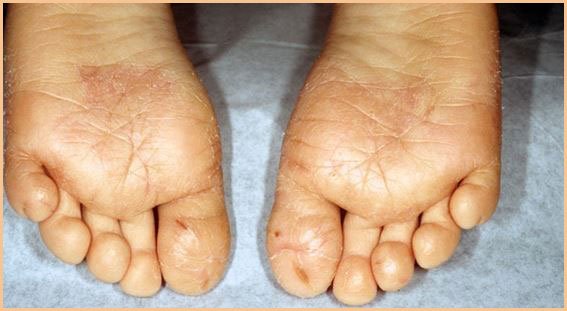How to treat tennis shoe dermatitis, start by identifying the specific substance irritating and avoid wearing those shoes. Cleanse the affected area with mild soap and water, patting it dry gently. Apply over-the-counter hydrocortisone cream to reduce itching and inflammation, or use calamine lotion for soothing relief. Avoid scratching and keep the area moisturized with fragrance-free moisturizer. If the condition persists or worsens, seek advice from a dermatologist for further evaluation and treatment options.
Identify the cause: Determine the specific substance or material in your tennis shoes that is triggering the dermatitis. Common culprits include rubber, adhesives, dyes, and certain types of fabric. Once you identify the cause, try to avoid it in future shoe purchases.
- Remove the irritant: Stop wearing the shoes that are causing the dermatitis. If possible, switch to a different pair of shoes that do not contain the problematic substances.
- Cleanse the affected area: Gently wash the affected skin with mild soap and lukewarm water to remove any residual irritants. Pat dry with a clean towel. Avoid scrubbing the area, as it may further irritate the skin.
- Apply soothing creams or ointments: Use over-the-counter hydrocortisone cream or ointment to relieve itching and inflammation. Follow the instructions on the packaging for application guidelines.
- Avoid scratching: Although it may be tempting, scratching the affected area can worsen the condition and lead to infection. If necessary, you can cover the area with a clean, breathable bandage to prevent scratching.
Moisturize the skin: Regularly moisturize the affected area with a fragrance-free, hypoallergenic moisturizer. This can help keep the skin hydrated and reduce itching and dryness.
How to Treat Tennis Shoe Dermatitis?
Avoid scratching, keep the area moisturized, and consult a dermatologist if symptoms persist or worsen.
Step into the realm of healing for tennis shoe dermatitis! Begin by saying goodbye to the troublemaker shoes and embracing footwear devoid of irritants. Perform a cleansing ritual with gentle care, banishing the residue of discomfort. Enchant the afflicted area with a potion of soothing creams and ointments, massaging relief into the skin’s tapestry. Resist the siren call of scratching, for it leads to perilous paths. Instead, swathe the area in a comforting veil of fragrance-free moisturizer. If the battle persists, seek the counsel of a dermatologist, the alchemist of skin, who shall craft a bespoke remedy for your unique tale.
Best Shoes for Contact Dermatitis
Finding the best shoes for contact dermatitis involves selecting footwear that minimizes contact with potential irritants and provides comfort for your specific condition. Here’s a step-by-step guide to help you:
- Choose breathable materials: Opt for shoes made of breathable materials such as genuine leather, mesh, or natural fabrics. These materials allow air circulation, reducing the likelihood of sweat buildup and irritation.
- Avoid synthetic materials: Stay away from shoes made of synthetic materials like vinyl, rubber, or PVC, as they can trap moisture and heat, leading to increased irritation. Look for shoes with minimal synthetic components.
- Select hypoallergenic options: Look for shoes labeled as hypoallergenic or specifically designed for sensitive skin. These shoes are often made with fewer chemicals and dyes that can trigger dermatitis.
- Check for removable insoles: Removable insoles allow you to replace them with orthotic or hypoallergenic alternatives. This customization can provide better support and reduce the risk of irritation.
- Opt for adjustable closures: Shoes with adjustable closures like laces, straps, or buckles offer a better fit and allow you to adjust the tightness to avoid friction and irritation.
- Prioritize cushioning and support: Look for shoes with adequate cushioning and arch support to ensure comfort and prevent pressure points that can exacerbate dermatitis symptoms.
- Test for potential triggers: Before committing to a new pair of shoes, test them by wearing them for a short duration to see if they cause any irritation or discomfort. Pay attention to any redness, itching, or blistering.
- Maintain proper foot hygiene: Regardless of the shoes you choose, maintain good foot hygiene by regularly washing and drying your feet, and wearing clean socks to prevent the accumulation of sweat and bacteria.
Shoe Allergy Home Remedies
Harness the power of nature and the nurturing touch of home remedies to alleviate the woes of shoe allergy. Embark on a journey of soothing relief with these unique steps:
- Chamomile Compress: Prepare a cup of chamomile tea and let it cool. Soak a clean cloth in the tea, wring out excess liquid, and apply it as a compress to the affected area. The anti-inflammatory properties of chamomile can help reduce itching and inflammation.
- Baking Soda Soak: Create a soothing foot bath by adding a few tablespoons of baking soda to warm water. Soak your feet in this solution for 15-20 minutes. Baking soda can help neutralize pH levels and relieve itching.
- Apple Cider Vinegar Rinse: Dilute apple cider vinegar with equal parts water and use the mixture to rinse your feet. The acidic properties of vinegar can help combat fungal or bacterial growth and reduce itching.
- Oatmeal Paste: Grind oatmeal into a fine powder and mix it with a small amount of water to create a paste. Apply the paste to the affected area, let it sit for 15-20 minutes, and rinse off with cool water. Oatmeal possesses anti-inflammatory properties and can provide soothing relief.
- Aloe Vera Gel: Extract fresh aloe vera gel from the plant and apply it directly to the affected skin. Aloe vera has moisturizing and anti-inflammatory properties that can help soothe itching and promote healing.
- Cold Compress: Wrap a few ice cubes in a clean cloth and gently apply it to the irritated skin for a few minutes. The cold temperature can help numb the area, reduce itching, and provide temporary relief.
- Honey Healing: Apply a thin layer of raw honey to the affected skin and leave it on for about 30 minutes before rinsing off with warm water.
Remember, while these home remedies may provide temporary relief, it’s important to consult a healthcare professional for a proper diagnosis and personalized treatment plan, especially if the symptoms persist or worsen.
Don’t miss watching: How to Watch US Open Tennis 2023
How to Watch Wimbledon 2023 Live
Tennis Shoe Dermatitis Big Toe
Conquer the discomfort of tennis shoe dermatitis on your big toe with these unique steps: liberate your toe from the culprit shoes, cleanse it gently, apply a targeted topical treatment, embrace open-toe shoes or barefoot freedom to minimize friction, protect the area with a barrier cream, and monitor for improvement. If the battle persists, seek the guidance of a dermatologist for expert aid.
Tennis shoe dermatitis affecting the big toe can be particularly uncomfortable, but there are steps you can take to address the issue. Here’s a suggested approach:
- Stop wearing the shoes: Remove the tennis shoes that are causing dermatitis on your big toe. Continuing to wear them will only exacerbate the condition.
- Cleanse the area: Gently wash the affected toe with mild soap and lukewarm water. Be sure to cleanse between the toes as well. Pat the area dry with a clean towel.
- Apply a topical treatment: Use an over-the-counter hydrocortisone cream specifically formulated for skin inflammation and itching. Apply a thin layer to the affected toe, following the instructions on the packaging.
- Avoid friction: If possible, go barefoot or wear open-toe shoes to minimize friction on the affected area. If you need to wear shoes, choose ones that are spacious and allow ample room for your big toe to breathe and move freely.
- Protect the toe: Consider applying a barrier cream or petroleum jelly to provide a protective layer over the affected toe. This can help prevent further irritation and promote healing.
- Monitor for improvement: Keep an eye on the condition of your toe. If there’s no improvement or if it worsens despite home care, it’s advisable to consult a dermatologist or healthcare professional for further evaluation and guidance.
Shoe Contact Dermatitis
Shoe contact dermatitis refers to the inflammation of the skin caused by contact with certain substances in shoes. It typically presents as redness, itching, and sometimes blisters or peeling skin on the feet. Treatment involves identifying and avoiding the irritant, cleansing the affected area, using soothing creams or ointments, and seeking medical advice if symptoms persist or worsen.

Shoe Allergy Symptoms
Shoe allergy symptoms can vary from person to person, but here is a general step-by-step breakdown of what you might experience:
- Initial discomfort: Shortly after wearing the shoes, you may start feeling some level of discomfort on your feet, typically in the areas where the shoes come into direct contact with your skin.
- Redness and inflammation: The affected areas may become red, swollen, and inflamed. This is a common symptom of an allergic reaction and indicates an immune response to the allergens present in the shoes.
- Itching and irritation: You may experience intense itching and a persistent urge to scratch the affected areas. This itching can be quite bothersome and may worsen with continued exposure to the allergens.
- Rash and blisters: In some cases, a rash may develop on the skin where it has come into contact with the allergens. The rash may appear as small bumps, raised patches, or even blisters, depending on the severity of the reaction.
- Peeling or flaking skin: As the allergic reaction progresses, you may notice peeling or flaking skin in the affected areas. This can be accompanied by dryness and a rough texture on the skin.
- Pain or discomfort: Severe shoe allergies can cause pain or a burning sensation in the affected areas, making it uncomfortable to walk or wear shoes.
If you suspect a shoe allergy, it’s recommended to consult with a healthcare professional or dermatologist for a proper diagnosis and guidance on managing your symptoms.
In Fine
We like to say that you get effective information on how to treat tennis shoe dermatitis. Addressing and treating tennis shoe dermatitis requires a comprehensive and personalized approach to alleviate discomfort and promote healing. By implementing a few key strategies, individuals can effectively manage this condition and prevent its recurrence.
First and foremost, it is crucial to identify the underlying cause of the dermatitis. Factors such as allergies to certain shoe materials, excessive moisture buildup, or friction-induced irritation can contribute to the development of this condition. Consulting with a healthcare professional or dermatologist will help pinpoint the exact cause and guide subsequent treatment.










